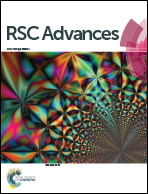A modeling study by response surface methodology (RSM) on Sr(ii) ion dynamic adsorption optimization using a novel magnetic ion imprinted polymer
Abstract
In this paper, response surface methodology (RSM) was successfully applied for the first time to optimize the dynamic adsorption conditions for the maximum removal of Sr(II) ion from aqueous solutions using Sr(II) ion imprinted polymers (Sr(II)-IIPs) as adsorbents. Sr(II)-IIPs based on the support matrix of magnetic SBA-15 (Fe3O4@SBA-15) were prepared by a surface imprinted technique and RAFT polymerization. The adsorbents can be separated from the fixed-bed column after adsorption by an external magnetic field. The effects of the operational parameters for maximizing Sr(II) removal were studied using Box–Behnken design (BBD) combined with RSM. A second-order quadratic model was built to predict the responses. The significance of the independent variables and their interactions was studied and tested by analysis of variance (ANOVA). The adequacy of the model was tested by the correlation between the experimental and predicted values of the responses. At optimum adsorption conditions, the Sr(II) adsorption capacity of Sr(II)-IIPs was found to be 22.12 mg g−1. Moreover, Sr(II)-IIPs exhibited an excellent dynamic selectivity of Sr(II) and could be easily regenerated by a dynamic desorption process with a desorption ratio of 99.2%.


 Please wait while we load your content...
Please wait while we load your content...